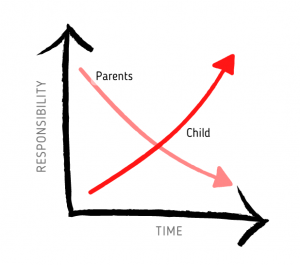This post series is intended for families who have lived with a food allergy diagnosis for a while, have mastered basic food allergy management skills, and are wondering how to transition food allergy responsibilities to their child with food allergies. This is the second post in our series on empowering your child with food allergies to self-manage them in the future — it’s all about loving by letting go as your child with food allergies grows.
Food Allergy Responsibility: Transferring Ownership to Your Child
Developing good food allergy habits, food allergy knowledge & know-how, and practicing them all are key to successfully empowering your child with food allergies to self-manage their food allergies. It’s a gradual process that unfolds over time in age appropriate ways as your child develops.

Post 1 in this three-part series highlights the importance of forming good food allergy habits when your child with food allergies is small. The focus of this second post is on the types of knowledge and know-how (i.e., knowledge sets) that will be important for your child to master by the time they are ready to live independently.
These first two posts discuss the ‘What’ your child needs to learn to fully self-manage their food allergies. The third post in this series focuses on the ‘How’, suggesting practical approaches for empowering your child to take charge of their food allergies.
“Smile, breathe, and go slowly.”
—Thich Nhat Hanh, a global spiritual leader, poet, and peace activist
Right Sizing The Effort
This series is meant to share perspective, not to overwhelm.
As you read, you may be thinking, “How can I possibly take on more? Do more?” because keeping your child safe with food allergies requires you to factor food allergy risk into everything you do, every minute of every day of every week.
This is where you need to pause. Step back. Consider a few things:
Tweaking vs. Adding
In many cases creating good food allergy habits and sharing knowledge are extensions of things you already do as a parent.
For example, you teach your child the words and associate meanings with the words for colors, shapes, animals, and foods. Is it such a huge step build in the concept of ‘safe food for you’ vs. ‘not safe food for you’?
For example, you proactively teach your child how to dress themself, as you first dress them, then help them dress. Is it such a huge step to add in allergy ID jewelry to the routine?
For example, you grab your purse, your keys, the snack bag and your child’s backpack when you head out the door when they’re little. Is it such a huge step to add in a medication bag check — together — to make sure the medication is in the ‘go bag’ before you leave home?
“Tell me and I forget, teach me and I may remember, involve me and I learn.”
—Benjamin Franklin
Doing With vs. Doing For
As you contemplate all food allergy knowledge sets you need to teach your child with food allergies, you may be thinking, “There aren’t enough hours in the day to do it all,” as you multi-task your way through your day in relentless pursuit of a shorter To Do List.
(First, the harsh reality — your To Do List isn’t going to get any shorter, whether you get through it at light speed or not. Second, an unfortunate fact of 21st century living — To Do Lists also multiply. They spawn new & improved {& longer} To Do Lists.)
SLOW COOK VS. PRESSURE COOK
Food allergy empowerment is ‘slow cooked’, not ‘pressure cooked’.
You may feel efficient, picking up that new epinephrine prescription by yourself before the babysitter goes home, or dropping off all the forms and Epi-Pens with the school nurse for a new school year by yourself on your way to work. But looking at this from another angle, your ‘efficiency’ may take real-time learning and practice opportunities away from your child with food allergies.
Can you slow your mad dash through the daily To Do List? Can you slow down {just a little} to include your child with food allergies in your food allergy To Do’s? Like:
- Going to the pharmacy together to pick up the new epinephrine for the school year.
- Stopping by the school nurse’s office together right before school starts to hand off your medical forms and medications together for safekeeping at school.
- Going to your 1:1 parent-teacher food allergy meeting together when the school year starts so your child is part of their teacher’s food allergy briefing and has a chance to give input.
Including your child in the process can definitely slow you down in the moment. No question. But in the long run, including your child in these small, repeated tasks over the years — and slowly expanding their role each year from supporting to leading — readies them to self-manage their food allergies down the road.
“Nothing is impossible, the word itself says ‘I’m possible’. “
—Audrey Hepburn, British actress and humanitarian
What Knowledge? What Know-how?
Following is the food allergy knowledge and know-how you will want your child to ‘own’ to fully manage their food allergies by the time they head to college and young-adulting.
This knowledge and know-how fall into two categories: Fundamentals and Applications.
Fundamentals: Fundamentals are specific knowledge sets about your child’s diagnosis, about handling allergic reactions, and about communicating their food allergy needs to others to stay safe.
Applications: Applications are common situations your child will encounter that require them to actively apply their Fundamentals to stay safe when handling the situation.
To have confidence in your child’s readiness to self-manage their food allergies, you will want to be able to answer YES to each of the questions below when it’s time for your child to leave home.
Fundamentals
1. THEIR FOOD ALLERGY DIAGNOSIS
You will want your child to know all the foods they are allergic to — what these foods look like, where they are commonly found in foods and at the grocery store, where they sometimes hide in foods. Beyond the specifics of their diagnosis, you will want your child to know how exposure to an allergen makes them feel and what they should do if they feel ‘off’ after eating something.
Here’s a knowledge checklist to help you gauge their fluency in their food allergy diagnosis as they mature. Does your child know?
- What foods are they allergic to?
- What foods are likely to contain their allergens and the less common names for their allergens?
- What non-food items could possibly contain their allergens (like pet food, like personal care products)?
- What cross contact is and how/where it can happen?
- Where their epinephrine auto-injector, antihistamine and any other emergency medications are at any given moment on any given day?
- What anaphylaxis is and the possible symptoms of anaphylaxis? (even if your child has never experienced anaphylaxis before.)
- What their past allergic reactions have looked/felt like?
- What their Food Allergy Action Plan (aka, Emergency Action Plan, Emergency Care Plan) says to do for mild and for severe allergic reactions.
- And , what steps they should take if they think they’re having an allergic reaction and in what order?
A couple challenges…
Your child’s food allergies may change over the years — so their allergen list may get longer or shorter as they mature. This variability can make it harder for your child to stay on top of their allergen list. By eighth grade, our son outgrew soy, shrimp and some tree nuts, but added lentils and chickpeas to the list. Even as late as 8th grade, he’d invariably forget to mention an allergen or two when he explained them to someone.
The symptoms of reactions can differ each time your child has one. Nor does the severity of past reactions predict the severity of future reactions. It’s quite possible that your child has yet to experience an anaphylactic reaction and use epinephrine, having only experienced mild allergic reactions to this point in their life. This potential for reaction variability and a lack of ‘lived experience’ can definitely add elements of uncertainty and second guessing when it comes to managing an actual reaction.
2. CARE & USE OF THEIR AUTO-INJECTOR
Your child needs to be within reach of their auto-injector 24:7. When they are little, you take the lead on keeping their device within reach, slowly relinquishing responsibility for carrying it through later childhood into adolescence as your child spends increasing amounts of time away from you with friends and at activities.
Over the years you will work with them to figure out solutions for conveniently and discretely carrying their auto-injectors themselves. You will give them opportunities to practice using their devices and navigate a prescription refill.
Here’s a knowledge checklist to help you gauge their mastery of the care and use of their auto-injector. Does your child know:
- What kind of auto-injector devices they carry?
- How their devices work and how to use them?
- When and how to call 911 for help for an allergic reaction?
- Why and when to use their second auto-injector?
- How to protect their auto-injector from temperature extremes — both hot and cold?
- How to track their auto-injector expiration dates and when to renew them?
- How to refill their auto-injector prescription?
- The care & use of your child’s epinephrine auto-injector is know-how that needs to be (and can be) baked in, in age appropriate ways, from their little years.
I reflect on this frequently. While my young adult son is diligent about going out and about with one auto-injector, it’s challenging to convince him to Carry 2. He will acquiesce when he’s traveling for fun or work. Carrying 2 was not something we modelled and insisted upon from his little years (protocols were different in the early 2000’s, and while ‘best practices’ evolved, our approach did not keep pace with the changes.) Given a do-over, equipped with 2022 knowledge, I like to think we would do better as parents and teachers.
3. SELF-ADVOCACY SKILLS & CONFIDENCE
A fundamental part of safe allergic living is the ability to explain your food allergies — clearly, precisely. Again. And again. This includes communicating what their food allergies are, what needs to be done to avoid exposure to their allergens, and how to recognize and manage a reaction.
Here’s a knowledge checklist to help you gauge their ability to self-advocate. Is your child able to:
- List all their food allergies and explain what help they need from others to stay safe?
- Share their food allergy details confidently and accurately with adults, people in positions of authority (e.g., like restaurant wait staff, dining services staff, coaches, professors, school nurses, medical professionals)?
- Talk proactively and openly with peers about their food allergies and needs (e.g., like bunkmates, romantic interests, roommates, RA’s, study partners, teammates)?
- Explain (teach) people in their circle of trust the symptoms of anaphylaxis, how to use their auto-injectors, what allergic reactions can look like, and what needs to be done to treat a reaction?
- Explain the details of their Emergency Action Plan (its location, its contents) confidently and accurately to friends, coaches, supervisors, a random flight attendant?
Your child’s temperament and personality traits all come into play here and will influence how they behave and interact with other people. Understanding your child’s temperament can help you adapt your food allergy parenting approach so you meet your child where they are. You want your approach to build on their strengths while setting appropriate {child centered} expectations for them to grow into their food allergy responsibilities.
Applications
Beyond the Fundamentals, during the years they are still at home with you, you will want to equip your child to anticipate and handle situations they will likely encounter living their lives. You have important lived experience to draw on — that they don’t have {yet} — that helps you anticipate and navigate fluid situations you encounter every day.
Following are skills you will want to help your child develop and master so they can safely navigate situations where their food allergies make them vulnerable.
These situations include purchasing packaged foods, dining out, and socializing with friends.
1. FOOD LABEL READING & INTERPRETATION
Food label reading is a chore — ingredients lists can be long, the typeface can be small and hard to see, store lighting may be dim, it takes time — but it’s vital for avoiding foods with allergens that can make your child sick, or even worse. When your child is small, it’s on you to read food labels at the store, when you put the food away at home, and again before you use it to prepare a meal. As your child grows, you will want to teach them how to accurately read and interpret food labels for their allergens, just like you do, every time they buy a packaged food item.
This skill set applies their knowledge of their food allergy diagnosis to determine what foods are safe to put in their shopping cart vs. not.
Here’s a knowledge checklist to help you gauge their mastery of food label reading & interpretation. Does your child know:
- How and where to find their allergens on food labels?
- What the less common names for their allergens are?
- What Precautionary Allergen Labelling {PAL} is and where it’s located on food labels?
- What ‘May Contain’ statements really mean & and how they should factor them into their ok-to-buy/do-not-buy decision making?
- How to interpret other PAL labelling related to manufacturing equipment and facilities and how they should factor it into their ok-to-buy/do-not-buy decision making?
- When and how to call a manufacturer for more allergen information and what questions to ask?
Mastery of this skill set has value beyond allergen avoidance because it can also raise your child’s awareness of the nutritional value of foods they buy — think net carbs, fats, protein, sodium content, vitamins & minerals, and chemical additives — and perhaps encourage healthier food choices.
2. RESTAURANT NAVIGATION KNOW-HOW
When you manage food allergies, choosing a restaurant isn’t a spur of the moment thing. The decision factors in whether or not your child can find something safe to eat there, something that won’t make them sick. It’s a carefully considered process that requires planning, trust and not a small amount of courage.
This skill set applies their knowledge of their food allergy diagnosis and their self-advocacy skills to clearly communicate their needs. Dining out involves trusting complete strangers, albeit professional cooks/chefs, to prepare safe food for them in kitchens that may or may not be particularly allergen-friendly.
Here’s a knowledge checklist to help you gauge their restaurant navigation know-how as they mature. Does your child know:
- What types of cuisine, in general, are particularly risky for their allergy profile (e.g., Chinese, Thai, Mexican, Indian, etc. cuisine)?
- What foods typically contain their allergens (e.g., like pesto, aioli, & BBQ sauces, or pizza)?
- How to find restaurant menus online and evaluate them for possible safe options?
- How to call ahead? What to tell the restaurant? What to ask?
- When to veto a restaurant and how to suggest alternatives?
- When and with whom to have their allergy conversation at the restaurant?
- What questions to ask about menu items and kitchen practices at the restaurant?
- What to do when they lose confidence in a restaurant after being seated and how to make a graceful exit if they choose to leave?
3. FOOD ALLERGY SOCIAL SAVVY
As parents, even though we might be tempted, we can’t bubble wrap our child to protect him/her from his allergens. Since the human experience is essentially a social experience — from the family unit, to friendships, to living, studying, worshiping, and working communities — it’s our job to empower them to live safely and freely socially, even with food allergies.
Here’s a knowledge checklist to help you gauge their social savvy. Does your child know:
- How to build a circle of trust with people who will be there for them in emergencies?
- How to evaluate social event risks before going? Who to ask? What to ask?
- How to devise practical comfortable-to-implement workarounds for event risks they uncover?
- Which alcoholic beverages are safe options for them (before they experiment, before they leave home)?
- What are some stay-safe strategies for navigating parties? (e.g., like eating before going, setting a consumption limit, not sharing drinks, drinking directly from bottles/cans vs. glasses, being wary of mixed/spiked drinks, avoiding drinking games, having face saving exit strategies at the ready)
- When romance is in the air, how & when to disclose their food allergies, and how to talk about ways to keep them safe with their special friend.
- How and when to {gracefully} opt-out of social situations.
The food allergy empowerment process ahead is not inconsequential. However, the process breaks down into discrete, manageable ‘chunks’ that can be demonstrated and explained to your child, and then practiced and practiced (and practiced some more) over time, over years. All of this takes place in bits and pieces, and often non-sequentially, as your child develops.
Ideally (in a perfect world?), as you hand off pieces of food allergy management, your child takes them on and ‘owns’ them….

…and, the sum of the pieces or ‘chunks’ eventually add up to an empowered, young adult capable of fully self-managing their food allergies.
(Reality check? Expect a few bumps in the road along the way as you love by letting go.)
When we get it right, we empower our child with food allergies with the habits, knowledge and know-how they need to stay safe and give them the ability to tap into all of it at the right time, in the right way, when it really matters.
“One day you will tell your story of how you overcame what you went through and it will be someone else’s survival guide.”
—Brene Brown, American research professor, lecturer, author & podcast host
Don’t miss Part 1 of this empowerment series that explores the importance of habits and the challenges of the adolescent brain when you’re working to empower your child with food allergies to 100% ‘own’ them down the road. Part 3 of the series dives deeper into practical approaches for handing off food allergy responsibilities to your child over time. And, please check out Allergy Force’s downloadable resources with specific tactics for helping your child learn how to self-manage their food allergies.
 |
Empowering people to live more easily & safely with food allergies through technology and education. |
| About the Author: Gayle Rigione is CEO of Allergy Force, the food allergy management app. She’s also an allergy mom. She’s lived the heart stopping moments when her son ate the wrong thing, second guessed reactions and spent the night in the ER. Her professional and personal experiences fuel her passion for creating tools for people with food allergies. Whatever you do, do it with a full heart. Audentes Fortuna Iuvat | |
Credits: Images courtesy of Allergy Force and Amber Faust on Unsplash


